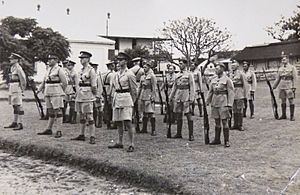Bermuda Volunteer Engineers facts for kids
Quick facts for kids The Bermuda Volunteer Engineers |
|
|---|---|

Cap Badge of the Corps of Royal Engineers
(the 1953-2022 version, with the Queen's crown) |
|
| Country | Bermuda (United Kingdom overseas territory) |
| Branch | |
| Type | Military engineering |
The Bermuda Volunteer Engineers (BVE) was a special part-time military group in Bermuda. It was formed between World War I and World War II. Its job was to take over from the Royal Engineers, a group of British Army engineers who left Bermuda in 1928.
Contents
History of the Bermuda Volunteer Engineers
Why the BVE Was Formed
For a long time, the British Army had many soldiers stationed in Bermuda. These soldiers helped protect the island. However, after the Crimean War, the British government wanted its colonies to have their own volunteer soldiers. This would help save money. Because of this, Bermuda created its own local military units. These included the Bermuda Volunteer Rifle Corps (infantry) and the Bermuda Militia Artillery (artillery).
The Royal Engineers were a very important part of the British Army in Bermuda. They built forts and other important structures. They also managed underwater mine defenses and operated searchlights to protect the harbors.
After World War I, the number of regular British soldiers in Bermuda was reduced. In 1928, the Royal Engineers were completely pulled out of Bermuda. The existing Bermudian volunteer units could take over some roles. But a new unit was needed to do the work of the Royal Engineers.
Starting the Bermuda Volunteer Engineers
The Bermuda Volunteer Engineers was officially created in June 1931. It started with a small group of soldiers. Their main job was to operate the powerful searchlights at the coastal artillery batteries. These searchlights helped defend the island's shores. The only battery still in use at that time was the Examination Battery at St. David's Head. Its guns were operated by the Bermuda Militia Artillery.
The first leader of the BVE was Captain H.D. Butterfield. He later became Sir Harry Butterfield. His second-in-command was Lieutenant Cecil Montgomery-Moore. Both men had served in World War I. In 1932, Captain Butterfield retired. Lieutenant Montgomery-Moore then became the new commanding officer. Lieutenant Nicholas Bayard Dill (later Sir Bayard) became the new second-in-command.
In 1937, the BVE took on even more responsibilities. They started providing communication equipment and crew for all parts of the military garrison in Bermuda. This meant they were in charge of signals, like radio and telephone communications.
The BVE in World War II

When World War II began, the BVE and other local units were called into full-time service. The BVE played its part in defending Bermuda throughout the war. Some members of the BVE also went overseas to serve with other British units. For example, four BVE soldiers joined a larger group from the Bermuda Volunteer Rifle Corps. This group went to serve with the Lincolnshire Regiment in June 1940.
One notable member was Lieutenant-Colonel Sir Richard Gorham. He joined the BVE in 1938. During the war, he served with the BVE's signaling division at the Royal Naval Dockyard. He later became an officer in the Bermuda Militia Artillery. He then went on to serve as an Air Observation Post pilot. This meant he flew planes to help direct artillery fire.
During the war, Cecil Montgomery-Moore was promoted to Major. Bayard Dill was promoted to Captain. Besides his role with the BVE, Major Montgomery-Moore also led the Bermuda Flying School. This school trained 80 local volunteers to become pilots for the Royal Air Force and the Fleet Air Arm. Some of these volunteers came from the BVE.
End of the BVE
After World War II ended in 1946, the Bermuda Volunteer Engineers was officially disbanded. This meant the unit was closed down. While other local volunteer units like the BVRC and BMA kept small command groups and started recruiting again later, the BVE did not.


